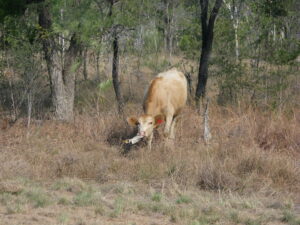Botulism
What is botulism?
Clostridium botulinum is the bacteria that causes botulism. The spores of this bacteria exist in the soil, sediment and in the intestinal tracts of healthy animals. As a spore, Clostridium botulinum occurs in a dormant (resistant to environmental degradation), or vegetative state (grows under anaerobic conditions where oxygen is excluded). It can also be found in carcasses, and at times, in plant material. In the vegetative state, Clostridium botulinum produces the botulinum toxin, where even only a small amount will cause disease.
The toxin causes paralysis when it binds to nerve endings. This prevents nerve impulses from transmitting messages to the muscles causing affected animals to appear ‘floppy’.
Once produced, the toxin is stable and may be present in carcasses or plant material for some time.
Symptoms
Symptoms vary depending on the amount of toxin ingested and any pre-existing immunity the animal may have obtained through vaccination. There may be sudden deaths (within 12-24hrs) or slowly progressive paralysis resulting in the animal taking days to die.
The first sign of botulism may be that cattle are off their feed and water. The jaw muscles and throat are the first to be affected, with a classic symptom of botulism being paralysis of the tongue. The tongue may easily be pulled out but will either retract slowly or not at all. Animals may mouth water at a trough but cannot swallow, as they cannot control their tongue.
Cattle will often develop a wobbly gait, commonly referred to as staggers, or may even have a stiff gait. The hindquarter of the animal is often affected before the forequarters. Often animals that have gone down with their hind legs stretched out, are unable to rise due to hind end muscle weakness. Mildly affected cattle are likely to recover, however once cattle go down their chances of recovery are poor.
In extensive operations, a problem may go unnoticed until abnormally high mortality rates are observed at mustering. Unfortunately, due to how botulism is spread, the carcases of these dead cattle pose a threat to the remainder of the herd and are best buried or burnt.
Testing for the presence of the toxin is both a difficult and expensive process, with testing of animal tissue, stomach contents, blood or feed samples frequently producing falsely negative results.
Treatment
Unfortunately, most animals that contract botulism and go down, die due to respiratory failure as the paralysis progresses through the animal’s body.

Sources
In intensive operations, the spread of botulism occurs primarily through contaminated feed (grain, hay, or silage), or water sources. Feed sources may contain the bacteria because bodies of small dead animals (mice, lizards, etc) are often accidentally incorporated during the harvesting, storage, or bailing processes. Stagnant water sources may contain the bacteria from bodies of small dead animals or decaying plant material.
Bone chewing, known as pica, is often observed in cattle that are protein or phosphorus deficient. This behaviour is hazardous as the decomposing carcase or bones may contain Clostridium botulinum, the botulism causing bacteria.
The risk of botulism is also present after flooding, where there is frequently decaying plant material and sometimes dead animals present within stagnant bodies of water that cattle may drink from.
Prevention is mostly about vaccination
An up-to-date vaccination program is the best defence in all beef operations that may become vulnerable to botulism. Addressing a phosphorus deficiency is another effective preventative form of action. Supplementing phosphorus to a deficient animal increases feed intake which results in improvements in growth, weight gain and fertility.
There are two botulism vaccines, an annual vaccine and a 3-year vaccine. The best vaccine option will vary depending on your enterprise management and record keeping. For example, larger operations that may not muster annually may find the 3-year vaccine a better option. Whilst an operation that grows out steers for slaughter may find the annual vaccination best for their operation. Additionally, for properties that have a problem with botulism most years, the 3-year vaccine would be the best to ensure there is an active preventative measure being implemented into the herd health management program. Similarly, for properties that may not have a problem but still want to vaccinate against the potential risk, the annual vaccine would be the best option, particularly for properties that grow out and move on their cattle to feedlots, as the feed present at the feedlot cannot be guaranteed to be contaminant free.
Something to note however, is that even when a phosphorus deficiency is addressed through adequate supplementation, this may not stop cattle chewing bones as this is now a learned behaviour. Therefore, appropriate disposal (burning or burying the carcass) and fencing exclusion zones, need to become a priority to reduce the risk and spread of botulism. Additionally, regular checking of water sources and cleaning of water troughs will aid in the prevention of spread of botulism.